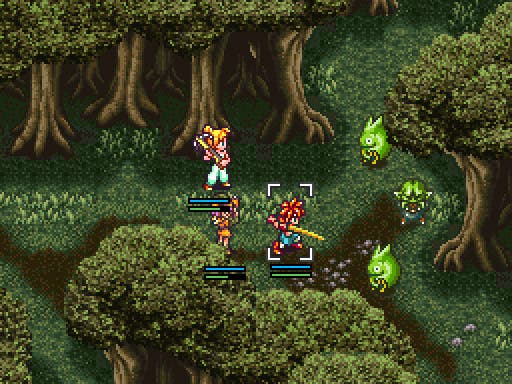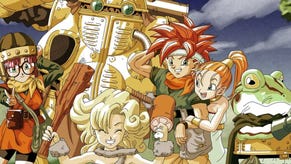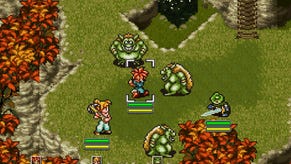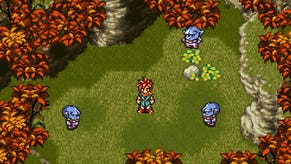Chrono Trigger
If I could turn back time.
But that's not to say the game's too worthy. In one memorable scene early on, Crono stands trial for crimes you're sure you never committed. During the trial, the prosecution shows footage of your actions earlier in the game, running from stall to stall at a bustling fair, 'stealing' goods from trestle tables. It's the game poking fun at your habit of clicking on everything; an excellent and surprising joke that not only ridicules the JRPG conventions its makers helped establish, but foreshadows the game's wider themes in a lighthearted way.
The removal of the JRPG's traditional fussiness is best exemplified by the battle system. Whenever Crono encounters an enemy on-screen his party springs into formation and the battle is underway. There's no protracted transition screen or stentorian fanfare. The active battle system ensures that combat is fast-paced and interesting, and the 'techs', special moves that work in a range of different ways for different characters, provide just enough depth and strategy to make the system interesting over the long haul.
The game's narrative strength, and the impact of its more poetic moments, is heightened by one of gaming's best-loved soundtracks. Yasunori Mitsuda, a young composer at Square hired three years previous to Chrono Trigger's development, was so desperate for a project to call his own that he gave Sakaguchi an ultimatum: give me a game to score or fire me. Under the watchful eye of Final Fantasy composer Nobuo Uematsu (who penned a few of the game's melodies himself), Mitsuda worked so hard on the soundtrack that he made himself physically sick, a dedication of effort that's comes through in the texture and nuance of the work.

So to the technical aspects of Chrono Trigger's port to DS. There are two modes: DS and Classic. The former places all of the menu options and a map on the touch-screen, clearing the game visuals of clutter, while the latter presents the original layout on a single screen. Many of the PlayStation port's additional features have been bundled in, including a bestiary, all-new anime-style cut-scenes, a music player and a treasure guide. There are a few new items and some new quest areas. These vary in quality but, without exception, fall short of the inventiveness of the original's missions. Finally, there's a new ending that attempts to tie the story of Chrono Trigger and its inferior PlayStation sequel, Chrono Cross, closer together. The additions are almost all welcome, but almost all unnecessary, save perhaps for the reworked translation that irons out some of the foibles of Ted Woolsey's original work.
The problem with remakes and ports for the critic, especially those of old beloved games, is emotional baggage. It's difficult to give a cold, measured critique of something you've loved since childhood. How can you give an objective appraisal when every time you hear the game's start-up melody your mind soaks happy in memories of warm endless school holidays, and that delicious, pure, all-encompassing escapism unique to children who play videogames? This game's story is also a part of my story, so it's impossible to get much distance between the two.
But for fans of the original game, there is no risk in coming to reassess those long-held opinions. Chrono Trigger is a masterclass in RPG design, its execution so far beyond the quality and poise of contemporary JRPGs it's embarrassing. It represents the work of a company at the very top of its field, a team of designers so confident with the rules that they helped establish that they felt free to subvert and invert them to glorious effect. While this is a game presented in simple 2D sprites and count-the-frames animations, its underlying maturity and creativity is somehow all the more potent for it. And in this DS update, everyone has the chance to turn back the clock to see how, in many ways, the Japanese RPG's brightest future still lies in its past.















